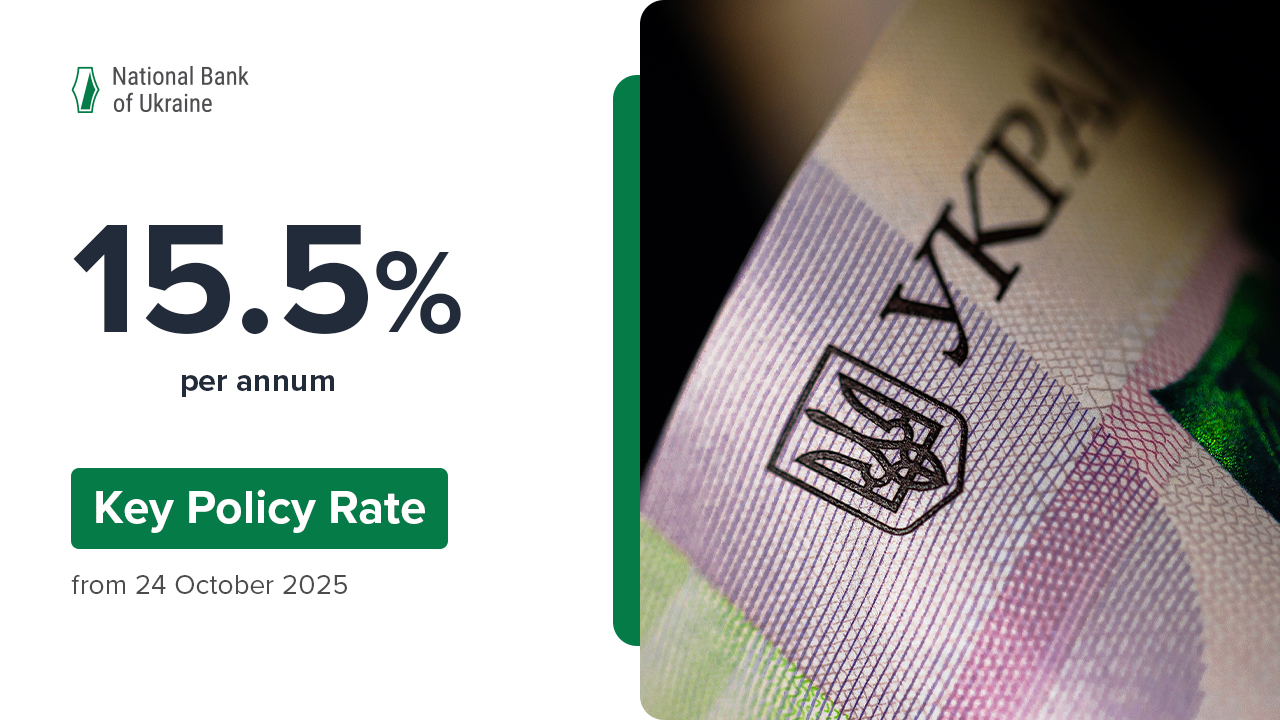NBU Governor Yakiv Smolii has announced changes to the denominations of hryvnia banknotes and coins aimed at streamlining the circulation of the hryvnia.
“Our national currency is what every one of us uses on a daily basis. Although cashless settlements are gaining increasing popularity in Ukraine, cash remains the most often used means of payment. Thus, the NBU must commit to making the hryvnia a quality, protected, and reliable currency and ensuring that hryvnia-based settlements are easy and convenient,” said Yakiv Smolii in an NBU press briefing.
To achieve those goals, the Governor said, the NBU intends to take the following steps:
- One-, two-, and five-kopiika coins will cease to be legal tender in Ukraine and will go out of circulation, effective 1 October 2019.
In addition, the 25-kopiika coin will continue to be used as legal tender for now, but will be phased out eventually.
- Beginning 25 October 2019, the NBU will put into circulation the 1,000-hryvnia note – Ukraine’s highest face value banknote so far.
As a result, when these coin withdrawals and the introduction of the new denomination banknote have been completed, the hryvnia denomination series will be reduced from 17 to 12 denominations.
“The new denomination series will have six coin denominations and six banknote denominations. This effort will streamline the denomination series,” said Yakiv Smolii. “Advanced countries such as the U.S., Canada, the UK, Czech Republic, Denmark, Switzerland, and Australia use 11 to 13 denominations of coins and banknotes.”
Rationale and Advantages
- Customer convenience
Too many denominations cause chaos in wallets and take extra time during payments.
“The changes the NBU has presented today will nearly halve the average number of coins per capita, and reduce the number of banknotes by almost a third. These changes will introduce greater ease into cash settlements and savings,” said Yakiv Smolii.
- Economic expediency
Considering the growth of income and prices, Ukrainians have essentially abandoned the use of low-denomination coins. Instead, there is demand for a banknote with a higher denomination than 500.
In particular, one-, two-, and five-kopiika coins are hardly ever used to pay for goods and services, and practically never go back into the banking system from circulation.
At the same time, all models that central banks have used to find an optimal denomination series show that it is time to introduce a new highest denomination.
The last time the NBU put a new denomination in circulation was in 2006. It was a 500-hryvnia banknote. At that time, the average monthly wage was about UAH 1,000, i.e. two highest-denomination banknotes.
“Much has changed since then. Ukrainians’ incomes have grown, with the average monthly wage in Ukraine increasing almost tenfold. Today, in order to pay out the average monthly wage, at least 20 banknotes are required. As a result, there is more cash in wallets, while the amount of cash increased almost fivefold, to UAH 380 billion,” said Yakiv Smolii.
The structure of cash in circulation has also changed. At present, 500-hryvnia banknotes account for over 55% – and 200-hryvnia banknotes for a third – of all banknotes. Considering the global experience, the 50% threshold is indicative of the need for a higher denomination.
“Thus, a new highest-denomination banknote has been long overdue. After the NBU introduces the 1,000-hryvnia banknote, the average monthly wage will be exchanged for nine banknotes of the highest denomination, making things more convenient than they are now.
- Reducing costs to the state and businesses
With the new denomination series in use, the state and other participants of cash circulation will have reduced their expenses on production, processing, transportation, and storage of banknotes and coins.
In particular, the production costs of one-, two- and five-kopiika coins greatly exceed their face values. The state will have saved over UAH 90 million per year in production and processing costs. Moreover, retailers, food service providers, transport companies, and banks will also save money while conducting cash collection and processing of these coins.
Regarding banknotes, the 1,000-hryvnia banknote will improve the cost-effectiveness of transportation and storage of paper money.
Terms and dates:
- The 1, 2, and 5-kopiika coins will cease to be legal tender in Ukraine from 1 October 2019. Since then, these coins will not be accepted as a payment for goods and services and the NBU will commence withdrawal of these coins from cash circulation.
At the same time, the public will be able to exchange these coins without limitations and free of charge for coins and banknotes of other denominations during the next three years.
- during the first years since the withdrawal date through 30 September 2020 - in any Ukrainian bank
- during three years since the withdrawal date through 30 September 2022 - at the NBU and authorized banks (Oschadbank, PrivatBank, Raiffeisen Bank Aval).
In addition, a gradual withdrawal of 25 kopiika coins will start. Unlike 1, 2, and 5 kopiikas, 25 kopiikas will for now remain in cash circulation. You can use them for payments. But these coins, if received by banks, will not be returned into circulation.
To ease cash settlements in Ukraine, rounding rules can be applied. Under these rules, the amount of a cash transaction involving goods an services (as printed on the receipt) can be rounded to the closest values divisible by 10 kopiikas*.
- Beginning 25 October 2019, the NBU will put into circulation the 1,000-hryvnia note – Ukraine’s highest face value banknote so far.
1,000 hryvnia banknote:
The front of the banknote features a portrait of Volodymyr Vernadskyi.
“He was selected for his tremendous contribution to the history of Ukraine as a philosopher, naturalist and the founder of new scientific disciplines (geochemistry, biochemistry and radiogeology). He was also one of the founders and the first president of the Ukrainian Academy of Science established in 1918”, said Yakiv Smolii.
The building of the Presidium of the National Academy of Sciences of Ukraine is at the back of the banknote.
The color and size of the banknote make it easily distinguishable from other denominations, which helps users recognize the denomination. The dimensions of the new banknote are 75 mm by 160 mm. The main color is blue.
“The new banknote incorporates top-notch design and security technologies”, mentioned Yakiv Smolii, “the design of the new banknote is similar to the designs of the upgraded 20, 100 and 500 hryvnia banknotes”.
The banknote has both paper-based and innovative printed security features:
- the window thread is a polymer thread partially embedded in the paper with the respective color (magenta) and a pronounced combined optically variable effects. The thread contains the digits representing the banknote’s face value and the trident, the small coat of arms of Ukraine. Tilting of the banknote brings out the kinematic effect, the background image moves in the opposite direction
- the SPARK OVI element with the kinematic effect. When the banknote is tilted, some areas of the image will gradually change the color (from golden to jade green).
Find more details on the security features and design of the new 1,000 hryvnia banknote in the presentation.
On the future plans:
The NBU intends to complete the current series of banknotes and coins with issuance of the upgraded 50 and 200 hryvnia banknotes.
Simultaneously, the NBU will start preparations to develop the design of the next hryvnia generation, even more future-poof.
“We are convinced that our currency shall celebrate the history of Ukraine and its key founding personalities, but also reflect the contemporary values of Ukrainians”. - said the NBU governor.
According to him, the new hryvnia generation will be born through the new open and inclusive process.
Biographical Information
Volodymyr Vernadskyi (28 February 1863 - 6 January 1945) is an outstanding Ukrainian philosopher, global thinker, scientist, naturalist and a founder of the new scientific disciplines (geochemistry, biochemistry and radiogeology).
He is well known as a founder of the new scientific fields and branches of science about the Earth, creator of the revolutionary studies about the biosphere, ingenious theorist that defined the mainstream cognitive science, ways of getting insights about the Universe and rules of civilization development.
He was also one of the founders and the first president of the Ukrainian Academy of Science that celebrated its 100th anniversary last year.
His authority as a scientist is unchallenged and his contribution to the global science was celebrated with numerous awards and his election as a member of the science academies and societies in different countries.
Vernadskyi’s life was closely connected with Ukraine that he researched, knew well and considered to be his land. He spent his childhood near Kharkiv. In the Poltava region he created his teachings about living matter and biosphere.
Volodymyr Vernadskyi was a patriot of Ukraine and foresaw a happy future of his nation that is destined to take its rightful place in Europe and in the world.
* Under the rules approved by NBU Board Resolution On Optimization of Circulation of Low-Denomination Coins dated 15 March 2018







